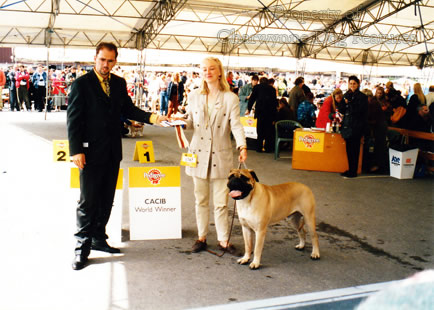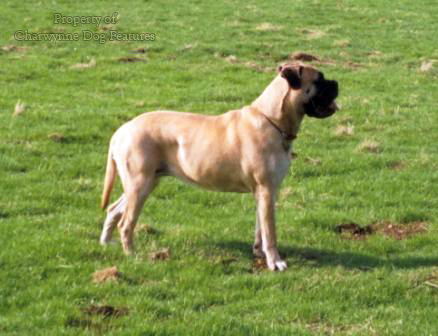328 Bullmastiff Type
WHAT IS TYPE IN A BULLMASTIFF?
by David Hancock



The only sad feature of walking a Bullmastiff for me is when other dog-walkers enquire whether the dog is a Rhodesian Ridgeback or worse a Boxer 'with a tail'. For English people, in the heart of England, to be able to come up with the name of a Rhodesian or German breed of dog and not be familiar with a native breed is, to me anyway, maddening. It reflects perhaps on past breed fanciers of Bullmastiffs, who have got on with 'fancying' and done little to educate the public or promote the breed. The appalling ignorance of those behind the disturbing anti-bullbreed prejudice in Germany recently, as well as the loose logic behind our now discredited Dangerous Dogs Act, shows what can happen if breed promotion is overlooked.
But, on the other hand, if a Bullmastiff is so badly bred that it resembles a hefty Pit Bull Terrier, the breed's cause is not helped, especially with the police, who have to implement the DDA. Some years ago, a couple came to my house to purchase a copy of my book on the breed; with them was their 'Bullmastiff'. This dog, friendly and well cared for, looked more like a Boxer than a Bullmastiff, a Boxer that is with a hare-lip! The dog's owners had been told by the well-known breeder of their dog that it would 'grow into that lip'. They really needed to be told too that it would never grow into a proper Bullmastiff!
I have rarely read a truly definitive article on what constitutes 'type' in any pure-bred breed of dog, so how on earth can judges spot it or indeed breeders breed for it? Oh, lots of writers have repeated sections of the breed standard or listed breed points as exemplars of breed type. But breed points can vary in value to the breed; type in any breed is only there when the essential breed points are displayed. I groan when I read show critiques, often by experienced judges, when they praise virtues in exhibits which are not embraced by the breed standard. That surely can only lead to the eroding of breed-type. You only have to look around the contemporary show rings to see that different Bullmastiff breeders are seeking noticeably different varieties of the breed.
So what constitutes true type in the breed of Bullmastiff? No breed standard tells you what is essential in each breed; it is for the Breed Council perhaps to set out the breed's stall. Too difficult to obtain agreement, the pessimists would claim. It varies from kennel to kennel, I was informed by one prominent breeder; so much for breed type! It's all in the breed standard, advised another breed elder; but is it? Why does the standard not state that the nose of a Bullmastiff should be black? The standard tells us that the ears should be 'folded back', but they are not actually desired to be so. What really makes the Bullmastiff the breed that it is?
How beneficial it would be, before any allrounder judged the breed for that judge to be handed, not just the breed standard, but those essential points which distinguishes the breed of Bullmastiff from say the Dogue de Bordeaux, the Mastiff, the Perro de Presa Canario or the Boerboel. All had a common origin yet have distinct differences, differences which really matter. Is a fawn Boerboel with a full tail not easily confused with a Bullmastiff? Is a brindle Mastiff, 26" at the shoulder, not very very similar to a Bullmastiff? I have seen a Dogue de Bordeaux, with a black nose, looking very much like a Bullmastiff with the same degree of 'wrinkle'. Would a fawn Canary Dog without cropped ears not look like a Bullmastiff?
If the Bullmastiff really is, in that damaging expression, a 'head breed', which of the different heads being presented to show ring judges at the moment, is the one most representative of the breed? If you read 'Exchange and Mart' magazine or attend unofficial bullbreeds' shows or rallies, you will know that Bullmastiffs are being crossed with Dogues de Bordeaux, Neapolitan Mastiffs and American Bulldogs. Bullmastiff devotees may not like it, but it is happening. Unless essential breed type is established for the Bullmastiff, breeders of these hybrids can pass off their pups as pure-bred Bullmastiffs; plenty of genuine Bullmastiff pups are sold without papers. 
The breed standard of the Bullmastiff does not mention the word 'mask' and does not stipulate a black nose. It could be argued that a black muzzle brings a black nose with it and that dark markings around the eyes constitute a mask. But why not spell it out and reduce the likelihood of arguments? If the black muzzle is essential, why isn't the black mask too? If the coat should be pure and clear in colour, how can two-tone coated dogs become champions? As they have. If the head typifies the breed, how can dogs win with muzzles far less than one third of the distance from the centre of the occiput to the tip of the nose? The words of the breed standard don't always protect the breed from its own breeders.
The Bullmastiff is expected to have well-boned forelegs but not well-boned hindlegs, yet be symmetrical in general appearance. Show critiques make constant mention of 'great bone' but the standard doesn't. A foreign judge at a 2001 championship show placed a Bullmastiff first in Group 2, stressing its 'outstanding bone'. Was he judging shire horses or a breed designed to be active? Another judge's critique in Feb 01 stated that: "I found so many which had ultra short muzzles; a number with over-wrinkled skulls and quite a few with loose flews." There are clearly Bullmastiffs being entered for major shows which defy their own breed standard. Do their owners actually know this to be the case? 
One Bullmastiff kennel seems to favour the Boxer-chin and has champions made up carrying this feature. Surely that is untypical? There were several exhibits at the BBL Spring 2001 show with lurcher tails and brown not fawn coats. No doubt they will be bred from! The breed standard has its faults but is quite specific on coat-colour and tail requirements. The judge at the Manchester 2000 show wrote: "This year marks the 75th anniversary of the KC recognition of the Bullmastiff as a pure-bred dog, yet after all this time there is still such a wide variation in type. In some of the classes I was hard pressed to find two of a kind." At the 2001 World Dog Show, a much younger breed, the American Staffordshire Terrier, attracted an entry which looked as though they had all come out of the same dam, so even was their appearance. Is it just a British inability to breed for type?
One breed council has pioneered a breed survey scheme and tries to grade breeding stock. If the breed of Bullmastiff is to maintain essential type, perpetuate the classic breed we inherited and not go forward as 'any variety mastiff-type', there is work to be done. The breed council could for example set out the ten essential points which embrace breed-type and persuade clubs to put up prizes for the entrant best encapsulating breed-type. Ah, the destructively-minded will claim: Surely the best dogs at the show must encapsulate breed-type. Nice try! But what if the dogs are judged on 'outstanding bone', have brown coats and lurcher tails? As the Americans say: Get real!
